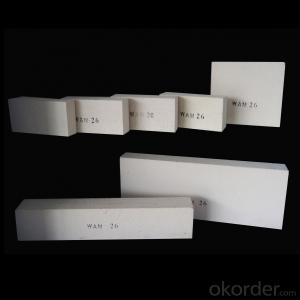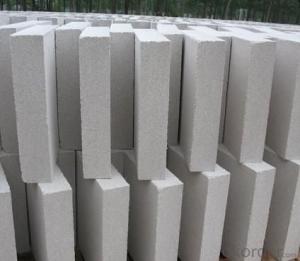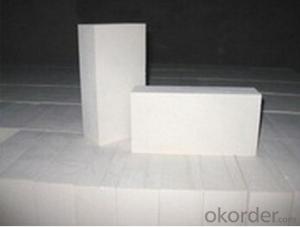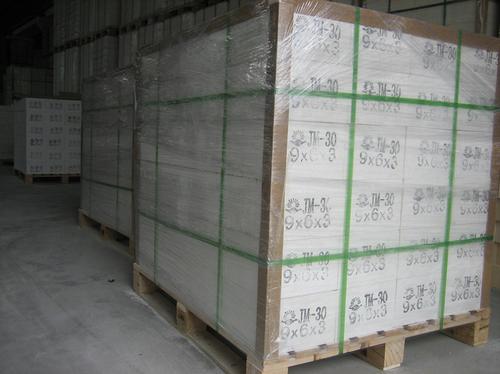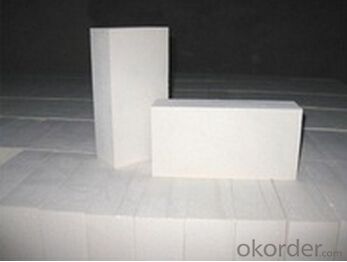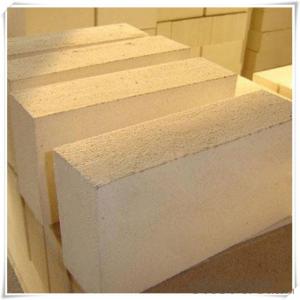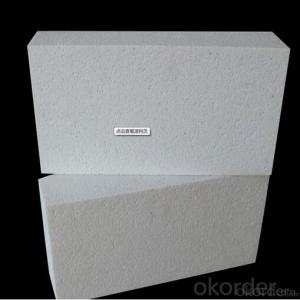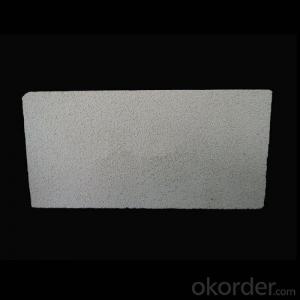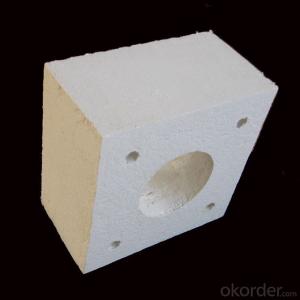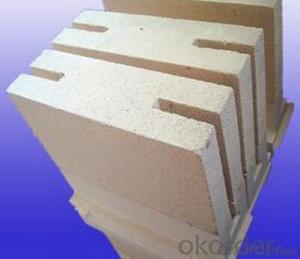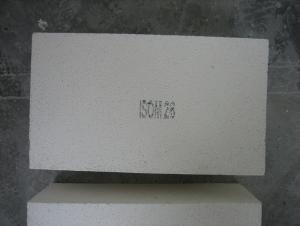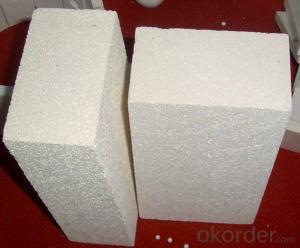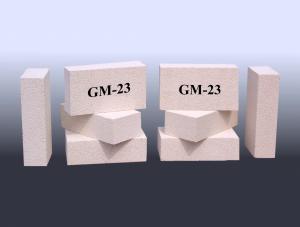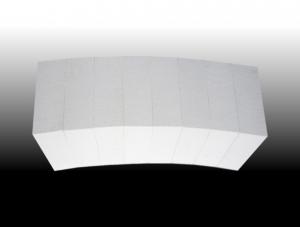Insulating Fire Brick - Refractory Mullite GJM26
- Loading Port:
- Shanghai
- Payment Terms:
- TT OR LC
- Min Order Qty:
- 20 m.t.
- Supply Capability:
- 100000 m.t./month
OKorder Service Pledge
OKorder Financial Service
You Might Also Like
General Information
CMAX insulating firebricks are classified under temperature between 1300℃ to 1700℃, manufactured from high purity alumina clay.
1. Lower content of iron, alkaline and impurities, good high temperature properties.
2. Homogeneous structure, light weight, energy saving because lower heat storage in the furnace during cooling cycles.
3. High strength, good thermal shock resistance under high temperature.
4. Precise sizes due to grinding and shaping after sintering, which meets the requirement of construction.
5. Max service temp: Up to 1730C (3160F)
Feature
Light weight and low thermal conductivity
Low heat storage
Low iron and impurities
High thermal shock resistance
Application
CMAX insulating firebricks can be used as a hot face lining directly exposed to the heat or as a backup insulation layer in iron and steel mills, non-ferrous foundries, petrochemical, ceramic, glass.
ITEM | GJM30 | GJM28 | GJM26 | GJM23 |
Classification Temperature, ℉/℃ | 3000/1650 | 2800/1540 | 2600/1430 | 2300/1260 |
Bulk Density,g/cm³ | ≤1.0 | ≤0.9 | ≤0.8 | ≥0.5 |
Reheating Linear Change, % | ≤0.9 (1550℃,12 h) | ≤0.8 (1510℃,12 h) | ≤0.7 (1410℃,12 h) | ≤0.5 (1230℃,12 h) |
Al2O3 Content, % | ≥75 | ≥65 | ≥55 | ≥45 |
Fe2O3 Content, % | ≤0.5 | ≤0.6 | ≤0.7 | ≤1.0 |
Thermal Conductivity: | ||||
800℃, w/m.k | ≤0.39 | ≤0.37 | ≤0.35 | ≤0.18 |
1000℃, w/m.k | ≤0.43 | ≤0.41 | ≤0.39 | ≤0.20 |
1200℃, w/m.k | ≤0.48 | ≤0.46 | ≤0.43 | --- |
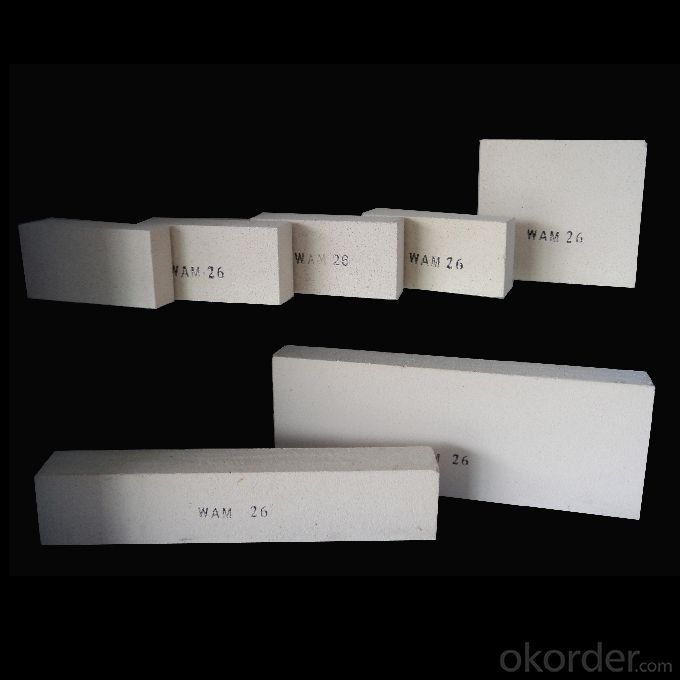
- Q: Do insulating fire bricks require any special curing or firing temperature profiles?
- Special curing and firing temperature profiles are indeed necessary for insulating fire bricks. These bricks are made from lightweight materials like perlite, vermiculite, or alumina silicate, all of which possess exceptional insulating properties. Their design enables them to endure high temperatures while providing superior thermal insulation. Throughout the manufacturing process, insulating fire bricks undergo a curing procedure to eliminate any moisture content. This is typically achieved by gradually raising the temperature in a controlled manner. The curing process is essential to prevent any potential cracking or damage that may occur if the bricks were subjected to high temperatures too quickly. When it comes to firing temperature profiles, careful consideration is required for insulating fire bricks. They are specifically designed for applications where temperatures can reach up to 2800°F (1538°C). Therefore, it is crucial to adhere to the recommended firing temperature profiles provided by the manufacturer. The firing temperature profile usually involves a gradual increase in temperature to allow the insulating fire bricks to reach the desired maximum temperature without experiencing any thermal shock or damage. This gradual heating process ensures that the bricks are adequately cured and capable of withstanding the extreme temperatures they will encounter during use. It is worth noting that the specific curing and firing temperature profiles may vary depending on the type and composition of the insulating fire bricks. Consequently, it is vital to consult the manufacturer's guidelines and recommendations to ensure the proper curing and firing process for the specific type of insulating fire bricks being utilized.
- Q: Can insulating fire bricks be used in the construction of tundishes?
- Yes, insulating fire bricks can be used in the construction of tundishes. Insulating fire bricks are lightweight and have excellent thermal insulation properties, making them ideal for applications where heat retention is important. Tundishes, which are used in the steel industry to control the flow of molten metal, require materials that can withstand high temperatures and minimize heat loss. Insulating fire bricks can withstand the extreme temperatures found in tundishes, helping to maintain the desired temperature of the molten metal and preventing heat loss. Additionally, their lightweight nature makes them easier to handle and install in tundish construction. Overall, insulating fire bricks are a suitable choice for the construction of tundishes due to their thermal insulation properties and ability to withstand high temperatures.
- Q: Are insulating fire bricks resistant to cracking under pressure?
- Insulating fire bricks exhibit resistance to cracking when subjected to pressure. They are specifically engineered to endure elevated temperatures and mechanical strain. Composed of lightweight materials with low thermal conductivity, like ceramic fiber or lightweight aggregates, these bricks maintain their structural integrity even under pressure or thermal expansion. Moreover, insulating fire bricks typically possess a significant alumina content, enhancing their strength and crack resistance. These qualities make them an excellent choice for applications requiring insulation and structural stability, such as furnaces, kilns, and high-temperature industrial processes. Nevertheless, it is crucial to acknowledge that excessive pressure or abrupt temperature changes can still harm insulating fire bricks. Thus, it is essential to adhere to proper installation and maintenance guidelines to ensure their durability and performance.
- Q: How do insulating fire bricks affect the overall sustainability of a structure?
- The overall sustainability of a structure is greatly enhanced by the use of insulating fire bricks. These bricks are designed to provide exceptional thermal insulation, resulting in reduced heat transfer and improved energy efficiency. Their ability to minimize heat loss or gain contributes to the sustainability of a structure in various ways. To begin with, insulating fire bricks play a crucial role in reducing energy consumption by maintaining a stable indoor temperature. Their excellent insulating properties prevent heat loss in the winter and heat gain in the summer, reducing the need for heating and cooling systems. As a result, energy consumption and the associated greenhouse gas emissions are lowered. In addition, the enhanced thermal insulation provided by insulating fire bricks leads to significant cost savings. Lower energy consumption translates into reduced utility bills, making the structure economically sustainable in the long term. Furthermore, the durability and longevity of these bricks mean that replacements or repairs are less frequent, further contributing to the economic sustainability of the structure. Moreover, insulating fire bricks improve occupant comfort, which is another aspect of a sustainable structure. With better insulation, the indoor temperature remains stable, creating a more comfortable living or working environment. This reduces the need for additional heating or cooling, ultimately enhancing the overall well-being and satisfaction of the occupants. Furthermore, insulating fire bricks have a positive impact on environmental sustainability. By reducing energy consumption, these bricks contribute to the conservation of natural resources and minimize the structure's carbon footprint. The decreased reliance on fossil fuel-based energy sources helps mitigate climate change and reduce air pollution. In conclusion, insulating fire bricks have a significant positive impact on the sustainability of a structure. They reduce energy consumption, improve energy efficiency, lower costs, enhance occupant comfort, and contribute to environmental sustainability. Therefore, incorporating insulating fire bricks in the design and construction of a structure is an effective way to promote sustainability and create a more environmentally friendly and economically viable building.
- Q: Are insulating fire bricks resistant to thermal spalling?
- Yes, insulating fire bricks are resistant to thermal spalling.
- Q: Can insulating fire bricks be used in carbon black reactors?
- Yes, insulating fire bricks can be used in carbon black reactors. Insulating fire bricks are designed to withstand high temperatures and provide excellent thermal insulation. In carbon black reactors, which typically operate at very high temperatures, insulating fire bricks can help to reduce heat loss and improve energy efficiency. Additionally, the insulating properties of these bricks can help to maintain a more stable temperature within the reactor, which is crucial for the carbon black production process. Therefore, using insulating fire bricks in carbon black reactors can be a beneficial choice in terms of both thermal insulation and energy conservation.
- Q: Are insulating fire bricks suitable for insulation in boilers?
- Yes, insulating fire bricks are suitable for insulation in boilers. Insulating fire bricks are specially designed to withstand high temperatures and provide excellent thermal insulation, making them ideal for use in boilers. They help to reduce heat loss, improve energy efficiency, and enhance the overall performance of the boiler.
- Q: Do insulating fire bricks require special handling?
- Yes, insulating fire bricks do require special handling. These bricks are made from lightweight refractory materials and are designed to withstand high temperatures. Due to their fragile nature, they should be handled with care to prevent breakage or damage. It is recommended to use proper lifting and carrying techniques, such as wearing gloves and using tongs or lifters, to avoid accidents or injuries. Additionally, insulating fire bricks should be stored in a dry and protected area to prevent moisture absorption, which can affect their thermal properties.
- Q: Are insulating fire bricks suitable for use in carbon black furnaces?
- Yes, insulating fire bricks are suitable for use in carbon black furnaces. These bricks are known for their high insulation properties, which help in maintaining high temperatures inside the furnace while preventing heat loss. Additionally, insulating fire bricks are designed to withstand extreme temperatures and chemical reactions, making them a suitable choice for carbon black furnaces that operate under high heat and harsh conditions.
- Q: Do insulating fire bricks require any curing or drying time before use?
- No, insulating fire bricks do not require any curing or drying time before use. They are ready to be used immediately after installation.
Send your message to us
Insulating Fire Brick - Refractory Mullite GJM26
- Loading Port:
- Shanghai
- Payment Terms:
- TT OR LC
- Min Order Qty:
- 20 m.t.
- Supply Capability:
- 100000 m.t./month
OKorder Service Pledge
OKorder Financial Service
Similar products
Hot products
Hot Searches
Related keywords

